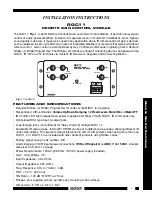
DER2 digital regulator instruction manual - rev. 02 - pag. 24
If the STAB trimmer is enabled (STAB Flag Trimmer present) its angular position, available at location
L[33], is transformed by the Fc
STAB
function into the numeric value available at location L[53] (figs. 9a and
9b). If the STAB trimmer is disabled, the value of location L[53] directly becomes the value set using the P
[20] parameter (fig. 9c).
The proportional gain K
P
is obtained by multiplying the value of location L[53] by a coefficient that depends
on the value given in parameter P[11].
Trimmer
STAB
L[33]
L[53]
2
P[11]
K
P
2
P[12]
K
I
P[13]
L[54]
Fc
STAB
()
fig. 9b: drawing of the numeric elaboration of the proportional and integral
gain by a DER2/A with the STAB trimmer enabled
The integral gain, available at location L[54] minus the multiplication by a coefficient, depends on the value
of the proportional gain at location L[53]; in the standard DER2 (standard) with the STAB trimmer enabled
(STAB Flag Trimmer present) the value of location L[53] at 50Hz is transformed by the function Fcig
50
and
by the multiplication of the value of parameter P[13], in the numeric value available at location L[54]; at
60Hz the transformation function is Fcig
60
, different from that at 50Hz, (fig. 9a); in the other versions of the
DER2 (fig. 9b), for example DER2/A (black box), or if the STAB trimmer is disabled
(fig. 9c), not only is
there a difference between the integral value at 50Hz and at 60Hz, but even the value of location L[54]
(
is
obtained by simply multiplying the proportional gain at location L[53] by the value of parameter P[13].
L[53]
2
P[11]
K
P
2
P[12]
K
I
P[13]
L[54]
P[20]
fig. 9c: drawing of the numeric elaborations of proportional and integral gain by all
DER2 with STAB trimmer disabled
In both cases, the effective integral gain K
I
is obtained by multiplying the value of location L[54] by a coeffi-
cient that depends on the value given in parameter P[12].
The mentioned coefficients can take on values of 1, 2, 4, 8, 16, 32 or 64 according to the values written in
parameters P[11] (for proportional gain) and P[12] (for integral gain); these values represent the value as-
signed to base 2 (fixed) to obtain the required coefficient (e.g. parameter P[11] = 4 => multiplication coeffi-
cient of the proportional gain = 2
4
= 16, P[12] = 3 => multiplication coefficient of the integral gain = 2
3
= 8).
The following tables show, for every three-phase machine on 50Hz and 60Hz, the STAB trimmer calibra-
tion which allows increased speed of response to the transistor with the generator in stand-alone opera-
tion. In case of different applications (for example alternators reconnected in single-phase, in parallel
among them or in parallel with the grid, with motors having less than 4 cylinders and so on) it may be nec-
essary to readjust the STAB trimmer calibration.
If the voltage cannot be stably adjusted for permanent operation and/or in the transient by the STAB trim-
mer settings, it may be necessary to vary one or more stability adjustment parameters: P[11], P[12] and P
[13] the description of which is given in table 6.
WARNING:
The benefits achieveble by the High Dynamic Response also depend on an accurate set-
ting of the dynamic response of the regulator: if the response is too slow the control system may not
require the excitation voltage inversion, in this case the module would not act and the trend would be
similar to a conventional regulator’s one.













































